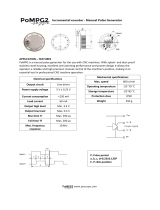
Hardware configuration.
CNC 8060
·9·
(REF: 1911)
SOFT 60 TANDEM AXES
Tandem axes.
A tandem axis consists in two motors mechanically
coupled (slaved) and making up a single transmission
system (axis or spindle). A tandem axis helps provide the
necessary torque to move an axis when a single motor is
not capable of supplying enough torque to do it.
When activating this feature, it should be kept in mind that
for each tandem axis of the machine, another axis must be
added to the entire configuration. For example, on a large
3-axis lathe (X Z and tailstock), if the tailstock is a tandem
axis, the final purchase order for the machine must
indicate 4 axes.
SOFT 60 SYNCHRONISM
Synchronization of axes and spindles.
The axes and ballscrews may be synchronized in two
ways: in terms of speed or position. The CNC
configuration takes into consideration the synchronization
of 2 axes or 2 spindles. Once synchronized, only the
master displays and programs the element.
SOFT 60 HSSA I MACHINING SYSTEM
High Speed Surface Accuracy.
This is the new version of algorithms for high speed
machining (HSC). This new HSSA algorithm allows for
high speed machining optimization, where higher cutting
speeds, smoother contours, a better surface finishing and
greater precision are achieved.
SOFT 60 HSSA II MACHINING SYSTEM
HSSA-II machining system.
This is the new version of algorithms for high speed
machining (HSC). This new HSSA algorithm allows for
high speed machining optimization, where higher cutting
speeds, smoother contours, a better surface finishing and
greater precision are achieved.
SOFT 60 PROBE
Probing canned cycles.
The CNC may have two probes; usually a tabletop probe
to calibrate tools and a measuring probe to measure the
part.
This option activates the functions G100, G103 and G104
(for probe movements) and probe canned cycles (which
help to measure part surfaces and to calibrate tools).
For the laser model, it only activates the non-cycle function
G100.
SOFT 60 CONV USER CYCLES
Conversational user cycles.
Incorporation of user cycles in conversational mode.
SOFT 60 PROGTL3
ProGTL3 programming language.
Another language apart from ISO for the programming of
profiles using a geometric language without the need to
use external CAD systems. This language allows for
program functions to define lines and circles which define
the points of intersection on a profile, in addition to macros
for the creation of solids defined by a flat profile and one
or more section profiles.
SOFT 60 PPTRANS
Part-program translator.
The program translator may be used to convert programs
written in other languages into Fagor ISO codes.
SOFT THIRD PARTY I/Os
Third-party CANopen.
Enables the use of non-Fagor CANopen modules.
SOFT MAB SYSTEM.
MAB drives.
Sercos connection with MAB drives.
SOFT 60 PWM CONTROL
Pulse-Width Modulation.
This function is only available for Sercos bus controlled
systems. It is mostly oriented toward laser machines for
the cutting of very thick sheets, where the CNC generates
a series of PWM pulses to control the power of the laser
when drilling the starting point.
This feature is essential for cutting very thick sheets and
it requires two quick digital outputs located on the central
unit. With this new feature, the OEM does not need to
install or program any external device, which reduces
machine costs and installation times. The end user also
benefits, since the “Cutting with PWM ” feature is much
easier to use and program.
SOFT 60 GAP CONTROL
Gap control.
This is mostly oriented toward laser machines. Gap
control makes it possible to maintain a set distance
between the laser nozzle and the surface of the sheet. This
distance is calculated by a sensor connected to the CNC,
so that the CNC offsets the sensor variations on the
distance programmed with additional movements in the
axis programmed for the gap.
SOFT DMC
Dynamic Machining Control.
DMC adapts the feedrate during machining to maintain the
cutting power as close as possible to ideal machining
conditions.
SOFT FMC
Fagor Machining Calculator.
The FMC application consists of a database of materials
to be machined and machining operations (milling and
turning) with an interface to choose suitable cutting
conditions for these operations.
SOFT FFC
Fagor Feed Control.
During the execution of a canned cycle of the editor, the
FFC function makes it possible to replace the feedrate and
speed programmed in the cycle with the active values of
the execution, which are acted upon by the feed override
and speed override.
SOFT 60/65/70 OPERATING TERMS
Temporary user license.
The "Operating Terms" option activates a temporary user
license for the CNC, which is valid until the date
determined by the OEM.
SOFT MANUAL NESTING
Manual nesting
Nesting consists of creating a pattern on the sheet material
using previously defined figures (in dxf, dwg or parametric
files), so as to use most of the sheet as possible. Once the
pattern has been defined, the CNC creates a program.
During manual nesting, the operator distributes the parts
on top of the sheet material.























